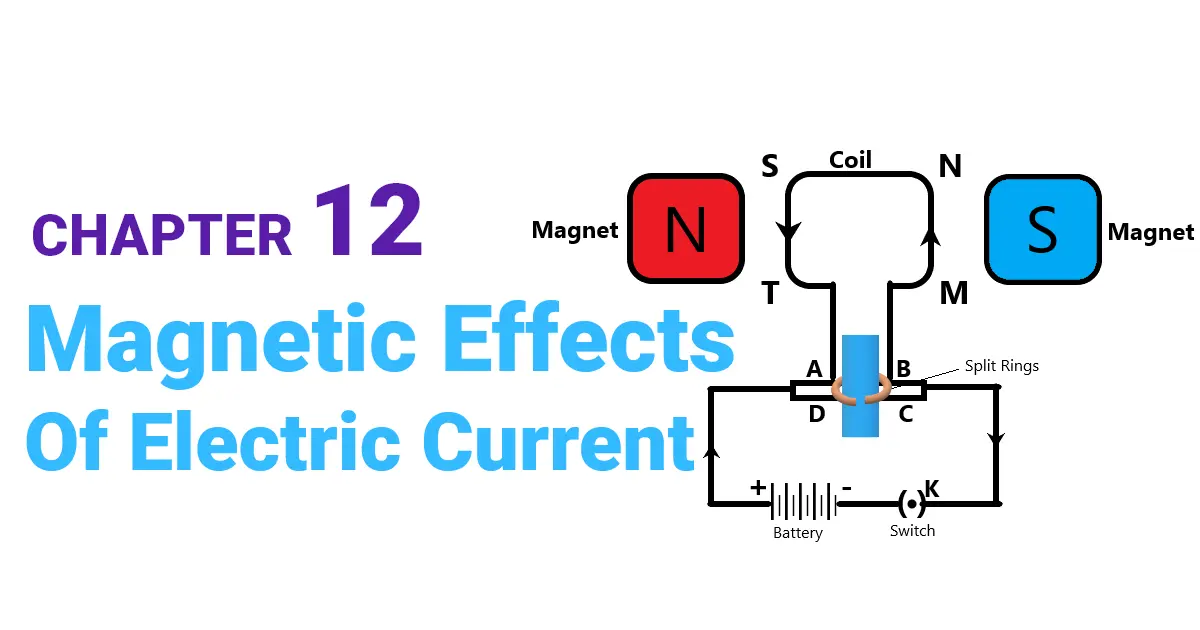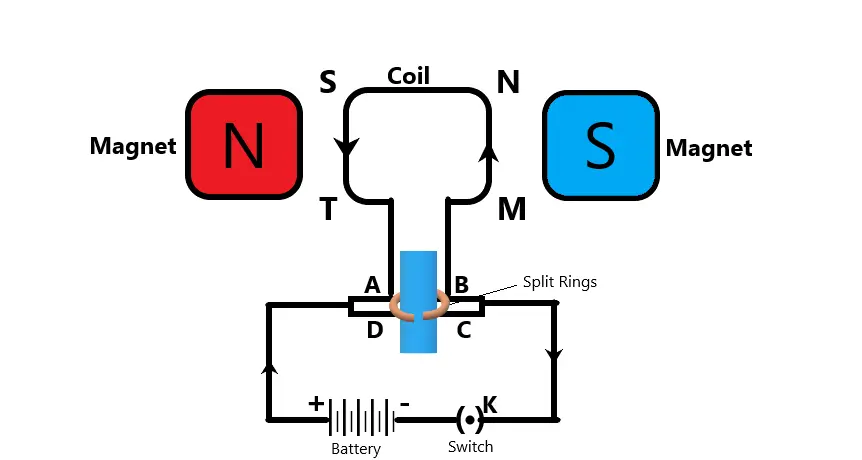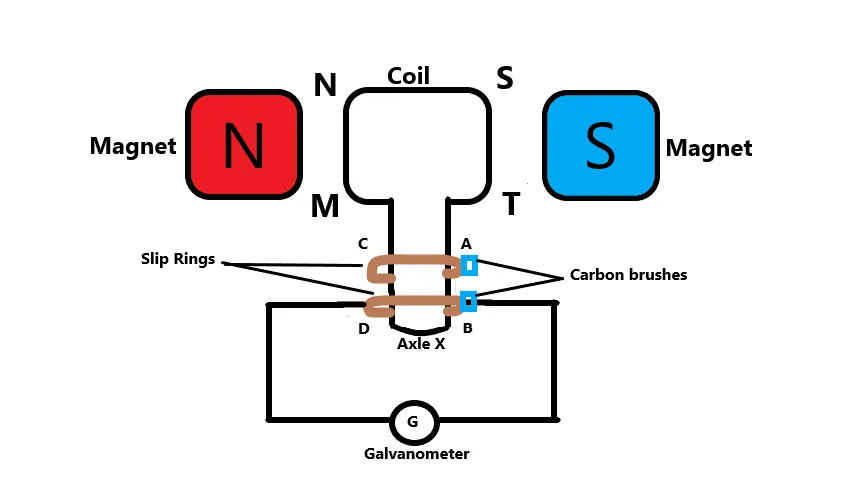NCERT Solution for Class 10 Magnetic Effects of Electric Current: The students who are looking for NCERT solutions for class 10 Science chapter 12 magnetic effects of electric Current will find all the information in this article. The best academic Noteschahiye experts have solved all the questions and answers related to the magnetic effects of electrical current for class 10 class NCERT solutions for the students who want to get a good grade on the class 10 board exam. So, read on to know all about NCERT solutions for science chapter 10 magnetic effects of electricity current for class 10 science.

NCERT Solution for Class 10 Chapter 12 Magnetic Effects of Electric Current
Before going into the specifics of NCERT solutions for class 10 Science chapter 12 magnetic effects of electric current, let us have a brief overview of the topics and sub-topics related to magnetic effects of electrical current class 10 pdf.
- Magnetic Effects Of Electric Current
- Magnetic Field And Field Lines
- Magnetic Field Due To A Current-Carrying Conductor
- Force On A Current-Carrying Conductor In A Magnetic Field
- Electric Motor
- Electromagnetic Induction
- Electric Generator
- Domestic Electric Circuits
Maths Important Questions for Class 10 NCERT (PDF)
Best Notes Making Format, Ideas And Examples 2023
Class 10th Notes Of Science 2023 Download New Syllabus Chapter-Wise
NCERT Solution for Class 10 Magnetic Effects of Electric Current Textbook Question
Q1.Which of the following correctly describes the magnetic field near a long straight wire?
a) The field consists of straight lines perpendicular to the wire.
b) The field consists of straight lines parallel to the wire.
c) The field consists of radial lines originating from the wire.
d) The field consists of concentric circles centered on the wire.
d) The field consists of concentric circles centered on the wire.
Q2. The phenomenon of electromagnetic induction is
a) the process of charging a body.
b) the process of generating a magnetic field due to a current passing through a coil.
c) producing induced current in a coil due to relative motion between a magnet and the coil.
d) the process of rotating a coil of an electric motor.
c) producing induced current in a coil due to relative motion between a magnet and the coil.
Q3. The device used for producing electric current is called a
a) generator
b) galvanometer
c) ammeter
d) motor
a) generator
Q4. The essential difference between an AC generator and a DC generator is that
a) AC generator has an electromagnet while a DC generator has permanent magnet.
b) DC generator will generate a higher voltage.
c) AC generator will generate a higher voltage.
d) AC generator has slip rings while the DC generator has a commutator.
d) AC generator has slip rings while the DC generator has a commutator.
Q5. At the time of short circuit, the current in the circuit
a) reduces substantially.
b) does not change.
c) increases heavily.
d) vary continuously.
c) increases heavily.
Q6. State whether the following statements are true or false.
a) An electric motor converts mechanical energy into electrical energy.
b) An electric generator works on the principle of electromagnetic induction.
c) The field at the center of a long circular coil carrying current will be parallel straight lines.
d) A wire with a green insulation is usually the live wire of an electric supply.
a) False because an electric motor converts electrical energy to mechanical energy.
b) True because electric generator works on the principle of electromagnetic induction.
c) True because a long circular coil is considere to be a solenoid and the magnetic field at the center of the solenoid is represente by parallel straight lines.
d) False because the wire with green insulation is usually the Earth wire and live wire has red insulation.
Q7. List two methods of producing magnetic fields.
- Two methods of producing magnetic fields are:
- It can be produced by a current-carrying straight conductor.
- It can also be produced by a permanent magnet.
Q8. How does a solenoid behave like a magnet? Can you determine the north and south poles of a current–carrying solenoid with the help of a bar magnet? Explain.
Solenoids are long insulating copper wires that are made up of long coils with circular holes.
A current-carrying conductor will always produce a magnetic field. So, when a current flows through your solenoid it will produce a magnetic field just like a bar magnet!
To figure out the north pole and south pole of a bar magnet, you need to bring the bar magnet near the ends of your solenoids.
The end of your solenoid attached to the positive end of your battery will act as a north pole, while the end attached to the negative end of your battery is going to act as a south pole.
Q9. When is the force experienced by a current–carrying conductor placed in a magnetic field largest?
The force of the current carrying conductor in the magnetic field is maximal when the current is flowing in the opposite direction of the
Q10. Imagine that you are sitting in a chamber with your back to one wall. An electron beam, moving horizontally from back wall towards the front wall, is deflected by a strong magnetic field to your right side. What is the direction of magnetic field?
We can find the direction of magnetic field using Fleming’s Left Hand rule when we are given the direction of the electric current and the force. In this case we are given that the beam of electrons moves from back to front. Thus, the current will flow from front to back wall. The direction of force is to the right side. Using Fleming’s left hand rule, we can say that the direction of magnetic field is downward.
Q11. Draw a labelled diagram of an electric motor. Explain its principle and working. What is the function of a split ring in an electric motor?
An electric motor works on the principle that a coil placed in magnetic field results in rotation of the coil. The structure of an electric motor is shown below:

The working of electric motor is as follows:
When the current passes through the coil MNST, the current in the coil flows from M to N and S to T.
According to Fleming’s left-hand rule, an upward force acts on the ST. Similarly, a downward force acts on the MN.
These opposite forces cause the coil MNST to rotate in the anticlockwise direction.
After half rotation, the brushes C and D change their position and the forces on arm MN and ST of the coil also reverse and the coil keeps rotating.
This cycle continues as long as the current is present in the coil.
Split rings in an electric motor are use to reverse the direction of the current in the coil of an electric motor so that it continues to rotate.
Q12. Name some devices in which electric motors are used.
Some devices which electric motors use are ceiling fans, washing machines, water pumps, etc.
Q13. A coil of insulated copper wire is connected to a galvanometer. What will happen if a bar magnet is
(i) pushed into the coil,
(ii) withdrawn from inside the coil,
(iii) held stationary inside the coil?
a) The galvanometer will show deflection because there is a relative motion between the coil and magnet and current is induce according to the principle of electromagnetic induction.
b) The galvanometer will show deflection because there is a relative motion between the coil and magnet and current is induce according to the principle of electromagnetic induction.
c) The galvanometer will not show any deflection because there is no relative motion between the coil and magnet.
Q14. Two circular coils A and B are placed closed to each other. If the current in the coil A is changed, will some current be induced in the coil B? Give reason.
When the current in coil A changes, the magnetic field associated with the coil A changes which changes the magnetic field associated with B also. Thus some currents induce in coil B by the principle of electromagnetic induction.
Q15. State the rule to determine the direction of a (i) magnetic field produced around a straight conductor-carrying current, (ii) force experienced by a current-carrying straight conductor placed in a magnetic field which is perpendicular to it, and (iii) current induced in a coil due to its rotation in a magnetic field.
(i) Maxwell’s right-hand thumb rule is use to determine the direction of magnetic field produced around a straight conductor-carrying current.
(i) Fleming’s left-hand rule is use to determine the force experienced by a current-carrying straight conductor placed in a magnetic field which is perpendicular to it
(i) Fleming’s right-hand rule is use to determine the current induced in a coil due to its rotation in a magnetic field.
Q16. Explain the underlying principle and working of an electric generator by drawing a labelled diagram. What is the function of brushes?
An electric generator works on the principle of electromagnetic induction according to which currents induce in the coil when it is rotating in a magnetic field. The diagram of an electric generator shows the below:

Working of electric generator is as follows:
When the axle of the electric generator is rotate in clockwise direction, the arm MN of the coil moves up while the arm ST moves down.
As the coil moves in a magnetic field, a current is induce in the coil due to electromagnetic induction.
The direction of the current is given by Fleming’s right-hand rule and is along M to N and along S to T in the coil.
After half rotation, the direction of movement of each arm reverses due to which the direction of current also reverses. Thus the current is termed as alternating current as the current reverses its direction after each half rotation.
The brushes of the generator are connecte to slip rings and the external circuit which helps to transfer the current produced by the electric generator to the external circuit with which it is connecte.
Q17. When does an electric short circuit occur?
An electric short circuit may occur due to the following reasons:
Short circuits are cause by overloading of the circuit or by connecting too many devices to a socket. Short circuits can also happen when two wires come into contact directly.
Q18. What is the function of an earth wire? Why is it necessary to earth metallic appliances?
In some cases, the current may also pass through the body of the appliances. Metallic appliances are also earthe to avoid shock to the user. The earth wire carries the current from the appliance body to the Earth which stops the user from getting an electric shock.
